Freddy Martin Show, The
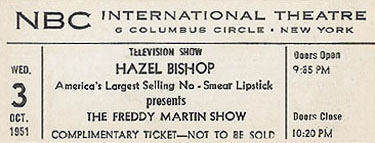
Freddy Martin was a popular “Big Band” leader who hosted a music show that ran on NBC starting on July 12, 1951 where it was a summer replacement for Martin Kane, Private Eye. Intended to go off when that show returned in the Fall, it stuck around on NBC until November. It was a half-hour of songs that is best remembered because of Freddy Martin’s lead male vocalist, Merv Griffin. It was Merv’s first TV show but it wouldn’t be his last.
Bert Parks’ Bandstand
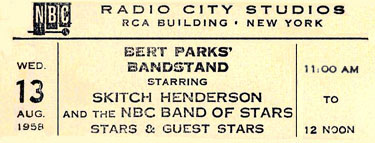
Bert Parks is probably best (only?) remembered for his years hosting the annual Miss America pageant. That’s a shame because he was a star on Broadway (among other gigs, he replaced Robert Preston in The Music Man) and he hosted dozens of game and variety shows. Bert Parks’ Bandstand was a daytime radio show based on the arguable premise that audiences didn’t want any of that new “rock-and-roll” music some kids were buying. They still wanted the Big Band sound…and that’s what Bert gave them, thanks to a fine big band under the baton of Skitch Henderson. Radio audiences kept it on for years but a TV version called NBC Bandstand didn’t do as well. The show debuted July 30, 1956 and had its last broadcast on November 23 of that year. It was replaced by a new show called The Price is Right.
That’s Life
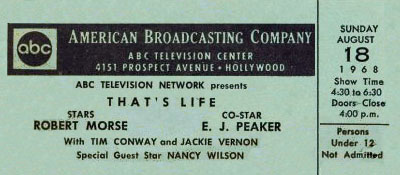
That’s Life was an extremely original and daring concept in TV: An hour-long ongoing sitcom and musical comedy that each week featured songs (some written for the show, some not) and dances. Robert Morse was the star and the show had something of the feel of his hit, How to Succeed in Business Without Really Trying. He played a young man named Robert Dickson while E.J. Peaker played his new wife, Gloria Quigley.
Each week, we got another chapter of their evolving life together, and there were guest stars aplenty. Among those who appeared, sometimes more than once as recurring characters, were Ethel Merman, Mel Tormé, Phil Silvers, Leslie Uggams, Paul Lynde, Vikki Carr, Mahalia Jackson, Alan King, Robert Goulet, Tony Randall and Liza Minnelli. Shelley Berman and Kay Medford turned up often as Gloria’s parents. The show also found ways to incorporate musical groups and their hits into its plot each week. On the first episode, which aired September 24, 1968, The Turtles sang “Eleanor.”
The above ticket is for August 18 and it’s for the second episode, which was telecast October 1 and told the story of how Bobby decided to ask Gloria to marry him. During the course of the hour, guest star Nancy Wilson sang “Marriage Blues,” E.J. Peaker sang, “It Must Be Him,” Morse sang, “Embarrassment of Riches,” Morse and Peaker sang “Our Love is Here to Stay” and”The Two of Us,” and Wilson and Peaker sang, “To Get a Man.” Guest stars Tim Conway and Jackie Vernon didn’t sing.
The series was a critical hit but that was about it. Audiences never discovered it…or if they did, they didn’t much like what they were watching. Twenty-six episodes were produced with the last airing April Fool’s Day of ’69. There were a few week of reruns and then the timeslot (Tuesday nights at 10) was given over to one night of a thrice-weekly Dick Cavett Show. That’s Life was never rerun again, which is a shame. It was one of those shows that deserved more of a chance.
Lennon Sisters Show, The
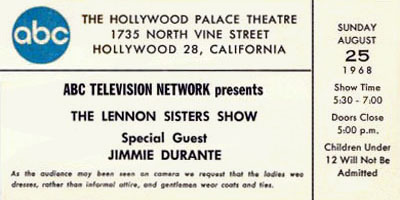
The Lennon Sisters were four toothy young ladies — Dianne, Peggy, Kathy and Janet — who became famous singing on The Lawrence Welk Show. How they got on that series is one of the simplest “rocket to stardom” stories in the history of show business. Lawrence Welk’s son Larry went to school with them and told his father about these sisters who were such fine vocalists. The elder Welk auditioned them and quickly added them to his “musical family,” which meant they got a lot of television exposure but not the highest paychecks.
They appeared on the Welk show from 1955 to 1968 when they decided it was time to do bigger, better-paying jobs. They’d had several successful record albums and this prompted ABC to star them in a special with special guest Jimmy Durante. (That was how Jimmy always spelled it despite the type on the above ticket.) The special did well enough to lead to a weekly series that began in September of 1969. It was called Jimmy Durante Presents The Lennon Sisters Hour.
The series began on a sad note: Six weeks before debut date, the father of the Lennon Sisters was shot to death in a parking lot. The shooter was a deranged fan who believed he was married to Peggy Lennon, and that the father was attempting to break them up. Perhaps that contributed to the low entertainment value of the series, which was cancelled in mid-season.
Hullabaloo
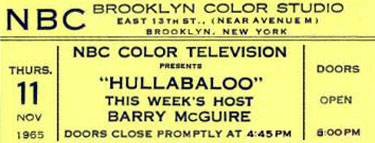
Hullabaloo was a prime-time series on NBC that showcased recording artists of the day. It debuted as an hour series on Tuesday, January 12, 1965 and was later shifted to Monday nights as a half-hour series. It lasted in the Monday slot until August 29, 1966.
Each week, a different guest host would be front and center, introducing that week’s acts and performing with the Hullabaloo dancers, a troupe of well-scrubbed, energetic young people. Future Broadway legends Michael Bennett and Donna McKechnie were among those who did The Frug and The Monkey, but most of the attention went to a particularly uninhibited young lady named Lada Edmund, Jr. The rumor was that in college dorms across the country, male students would gather and watch Ms. Edmund gyrate with the sound on the TV turned off.
The guest list of Hullabaloo was an odd mix of rock performers and mainstream TV personalities. The show booked The Rolling Stones, The Moody Blues and The Yardbirds, but it also booked Don Adams, Soupy Sales, Michael Landon and Vicki Carr. Gary Lewis and the Playboys seemed to pop up every other week. Brian Epstein, who was famous as the manager of The Beatles, consulted and sometimes introduced British acts…but apart from a few snippets of tape, the Beatles themselves were absent from the program.
Some episodes of Hullabaloo were taped at Radio City in New York but by the date on the above ticket, they’d been exiled to the NBC facility in Brooklyn. Rumor has it that this was because of the teenagers who were lining up the night before to be in the audience for the tapings, and cluttering the sidewalks and hallways.
Tony Orlando & Dawn
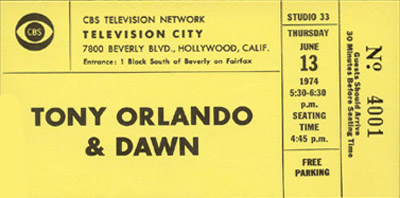
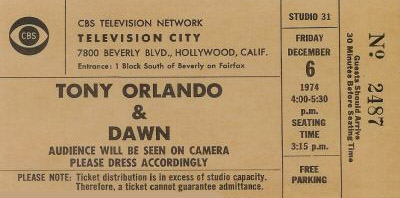
Before he “made it,” Tony Orlando drifted back and forth between working behind the scenes in the record business and in front of the microphone. Once he and two back-up singers scored big with “Candida,” “Knock Three Times” and “Tie a Yellow Ribbon ‘Round the Ole Oak Tree,” TV execs came calling, hoping the replicate the success of Sonny and Cher in a variety format. Orlando and the two ladies who comprised Dawn (Telma Hopkins and Joyce Vincent Wilson) didn’t quite have the same knack for snappy and mutually-insulting banter but their show had enough music and enough energy, as well as a stellar array of guests. It debuted as a summer series in 1974 and managed to stick around until December of ’76. For its last gasp, it was renamed The Tony Orlando and Dawn Rainbow Hour, as a way of signalling that it was undergoing some kind of unspecified revamp. The new title doesn’t seem to have meant much difference to anyone.
The reference on one of the above tickets to the audience being seen on camera refers to a weekly segment in which Orlando would wade out into the crowd, perform in the aisles and sometimes get audience members up to sing and dance with him. It became a signature routine of his and one that sparked battles amidst the show’s production staff and at the network, some of whom felt it was amateurish. The live audience loved it (no surprise) and each week, the producers would way overtape such material, then quarrel in the editing room over how much to include. There’d be pointed arguments that every song that Tony performed with a fat lady in an aisle seat meant they’d have to cut out a polished, rehearsed musical spot with one of the show’s well-paid and professional guest stars. On the other hand, even those who fought for less audience numbers had to admit that Tony was never better than when he and his fans were energizing one another. He had a genuine love for the people who came to see his shows tape (and vice-versa) and that probably is what is best remembered from that series.
Lloyd Thaxton Show, The
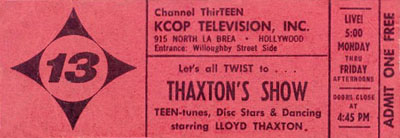
Lloyd Thaxton was a fixture of Los Angeles TV for much of the sixties, primarily for an afternoon dance party show not unlike Dick Clark’s American Bandstand. Thaxton’s had a couple of different names — Lloyd Thaxton’s Record Shop, The Lloyd Thaxton Show, Thaxton’s Show and others — but they were all Lloyd with a bunch of local teens, a few musical guests and a lot of clever games and stunts.
Working with almost no budget in the shabby studios of KCOP, Channel 13, Thaxton came up with ingenious ways to keep viewers interested when all he did was to play current hits and let kids dance to them. Recording artists would come on and lip-sync their records…and I always liked the fact that they usually wouldn’t assume we thought they were playing and singing live. They’d own up to the miming…and if the performer didn’t seem to know the lyrics to their own song, as was sometimes the case, Thaxton would run over and mix up the cue cards to throw them further off. He’d also get up himself and lip-sync to a Bobby Darin or Bobby Vinton record. Teenagers who showed up with tickets like the one above would dance or participate in games but Thaxton would also select some of them to get up and pretend to be Chad and Jeremy or Sonny and Cher or someone and lip-sync to those performers’ hits. Sometimes, Lloyd would take a photo of a singer or an album cover with a close-up of the artist’s face, cut out the mouth area, insert his own lips and “sing” the song that way.
What made it all work was Thaxton himself. He was unpretentious, self-effacing and funny…more than could be said for most of those who went up against him with similar shows. There were a number of them because they didn’t last, while Thaxton went on and on…all the way until around 1968 when all the local stations were getting out of producing their own shows. For the last few years, he was also syndicated and the show did well in other cities, as well. The trouble was that with the rise of afternoon talk shows and stations expanding their news broadcasts, there were no time slots for it. Thaxton moved on to host a few game shows that didn’t last, then moved to the other side of the camera as a producer and writer.
I used to see him in the hallways at NBC when I was writing a show that taped there and he was producing a series with consumer advocate David Horowitz. He always looked so busy, rushing to some meeting or something, that it was awkward to stop him and tell him how much I’d enjoyed watching his show. Finally one day, I approached him and got about six words into what I wanted to say before someone came running down the hall to tell him there was an urgent phone call. He excused himself and ran off and I never got to finish. I thought of calling his office and leaving it on his voice mail but I was afraid he’d just lip-sync to it.






